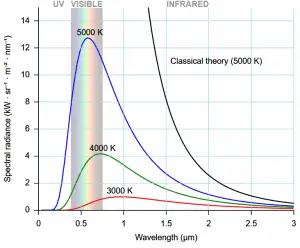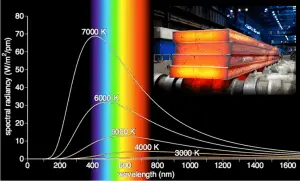Studying the laws of black bodies and the failure of classical physics to describe them helped establish the foundations of quantum mechanics.
Before Planck’s hypothesis, physicists tried to describe the spectral radiance of electromagnetic radiation by classical physics. The approximation based on classical physics is known as the Rayleigh-Jeans law.
Similarly, as for Planck’s law, the Rayleigh-Jeans law gives the spectral radiance of a body as a function of frequency ν at absolute temperature T:
- Bν(v, T) is the spectral radiance (the power per unit solid angle and unit of area normal to the propagation) density of frequency ν radiation per unit frequency at thermal equilibrium at temperature T
- c is the speed of light in a vacuum
- kB is the Boltzmann constant
- ν is the frequency of the electromagnetic radiation
- T is the absolute temperature of the body

Source: wikipedia.org License: Public Domain
The electromagnetic spectrum predicted by this formula agrees with experimental results at low frequencies (large wavelengths) but strongly disagrees at high frequencies (short wavelengths). This inconsistency between observations and the predictions of classical physics is commonly known as the ultraviolet catastrophe or Rayleigh-Jeans catastrophe. By calculating the total amount of radiant energy (i.e., the sum of emissions in all frequency ranges), it can be shown that a blackbody, in this case, would release an infinite amount of energy, which is in contradiction with the law of conservation of energy.
Studying the laws of black bodies and the failure of classical physics to describe them helped establish the foundations of quantum mechanics. A solution to this problem was proposed by a German theoretical physicist Max Planck, who introduced a very strange assumption (for the time), that energy is radiated and absorbed in discrete “quanta” (or energy packets). Planck’s assumptions led to the correct form of the spectral distribution functions:
- Bν(v, T) is the spectral radiance (the power per unit solid angle and unit of area normal to the propagation) density of frequency ν radiation per unit frequency at thermal equilibrium at temperature T
- h is the Planck constant
- c is the speed of light in a vacuum
- kB is the Boltzmann constant
- ν is the frequency of the electromagnetic radiation
- T is the absolute temperature of the body
Albert Einstein solved the problem by postulating that Planck’s quanta were real physical particles, what we now call photons, not just mathematical fiction.
Blackbody Radiation
It is known that the amount of radiation energy emitted from a surface at a given wavelength depends on the material of the body and the condition of its surface, as well as the surface temperature. Therefore, various materials emit different amounts of radiant energy even when they are at the same temperature. A body that emits the maximum amount of heat for its absolute temperature is called a blackbody.
 A blackbody is an idealized physical body that has specific properties. By definition, a black body in thermal equilibrium emissivity of ε = 1.0. Real objects do not radiate as much heat as a perfect black body, and they radiate less heat than a black body and therefore are called gray bodies.
A blackbody is an idealized physical body that has specific properties. By definition, a black body in thermal equilibrium emissivity of ε = 1.0. Real objects do not radiate as much heat as a perfect black body, and they radiate less heat than a black body and therefore are called gray bodies.
The surface of a blackbody emits thermal radiation at the rate of approximately 448 watts per square meter at room temperature (25 °C, 298.15 K). Real objects with emissivities less than 1.0 (e.g., copper wire) emit radiation at correspondingly lower rates (e.g., 448 x 0.03 = 13.4 W/m2). Emissivity plays an important role in heat transfer problems. For example, solar heat collectors incorporate selective surfaces with very low emissivities. These collectors waste very little solar energy through the emission of thermal radiation.
Since the absorptivity and the emissivity are interconnected by Kirchhoff’s Law of thermal radiation, a blackbody is also a perfect absorber of electromagnetic radiation.
Kirchhoff’s Law of thermal radiation:
For an arbitrary body emitting and absorbing thermal radiation in thermodynamic equilibrium, the emissivity is equal to the absorptivity.
emissivity ε = absorptivity α
A blackbody absorbs all incident electromagnetic radiation, regardless of frequency or angle of incidence, and its absorptivity is equal to unity, which is also the highest possible value. A blackbody is a perfect absorber (and a perfect emitter).
Note that visible radiation occupies a very narrow spectrum band from 400 to 760 nm. We cannot make any judgments about the blackness of a surface based on visual observations. For example, consider a white paper that reflects visible light and thus appears white. On the other hand, it is essentially black for infrared radiation (absorptivity α = 0.94) since they strongly absorb long-wavelength radiation.

